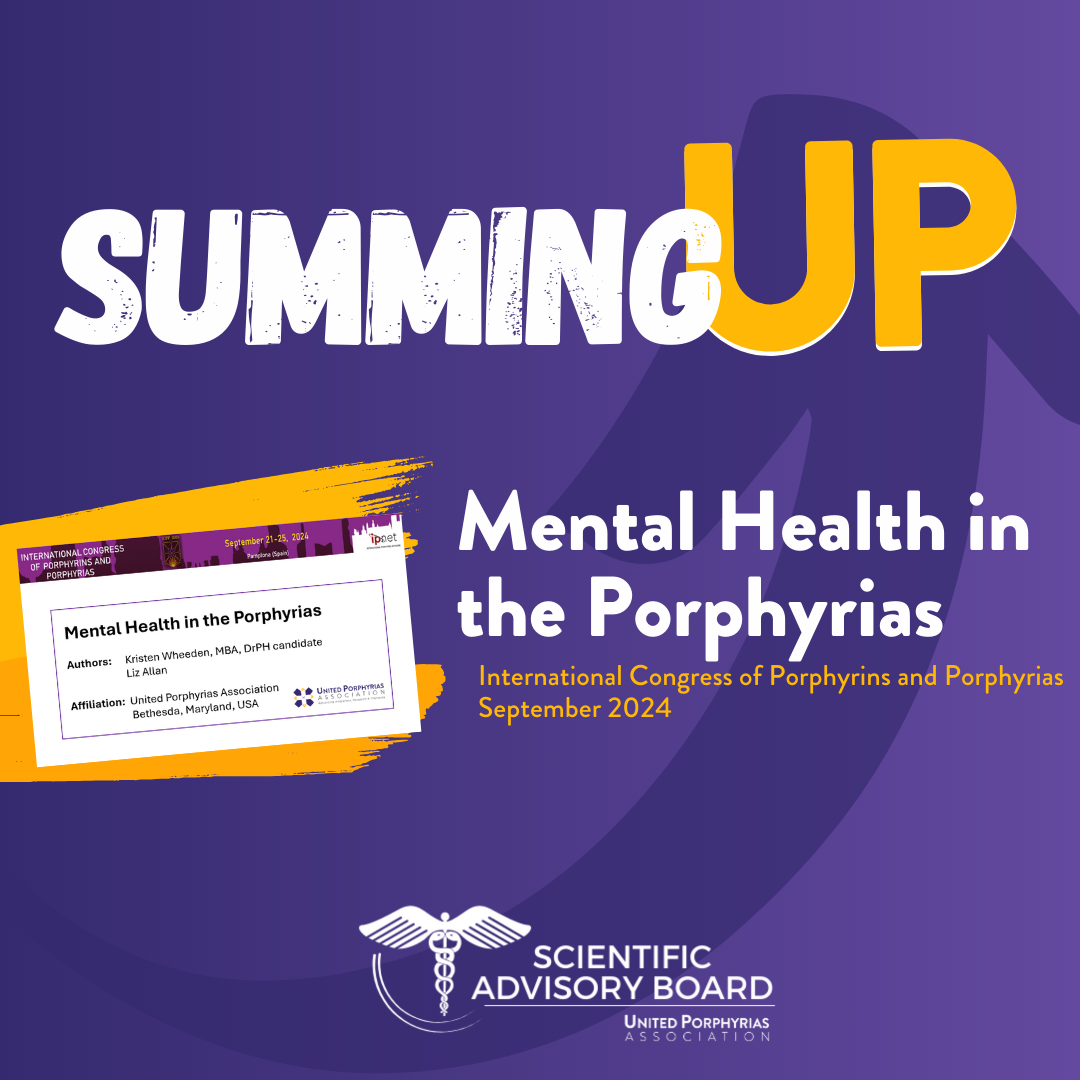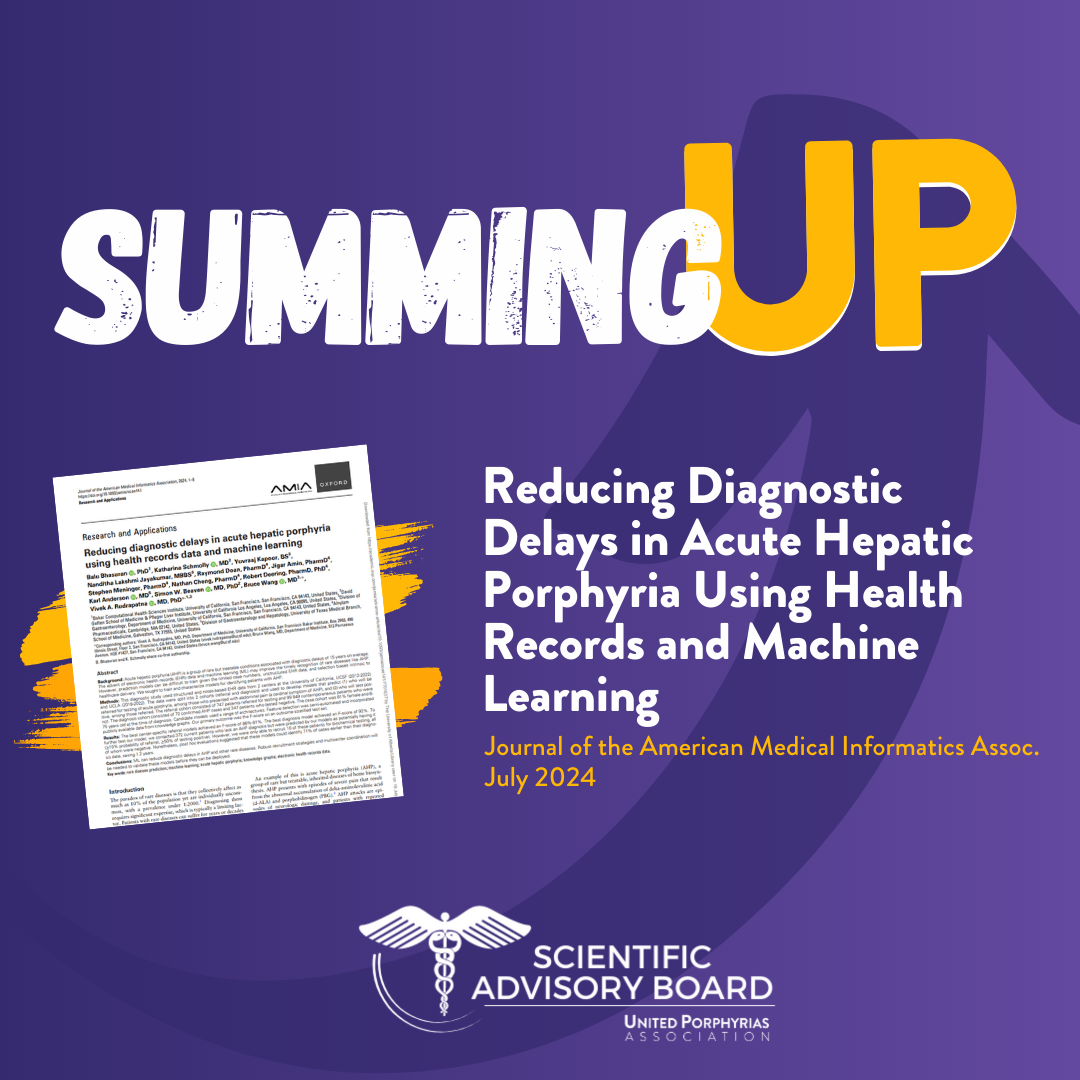Acute hepatic porphyria and anaesthesia
Summing UP features the latest porphyria research in easy-to-understand summaries that have been reviewed and approved by the UPA's Scientific Advisory Board of porphyria experts.
Acute hepatic porphyria and anaesthesia: a practical approach to the prevention and management of acute neurovisceral attacks
Full article: https://www.ncbi.nlm.nih.gov/pmc/articles/PMC7810766/
Published February 2021 in BJA Education
Surgery and the use on anesthesia require special considerations for patients with acute hepatic porphyrias (AHP- includes AIP, VP and HCP). This article provides an overview* of precautions for the period before, during and after an operation (the ”perioperative period”) for patients with AHP.
*Note: please refer to the full article for a fuller understanding and when making care decisions.
Is it safe to undergo surgery if you have an AHP?
Surgery can be safely undertaken in patients with porphyria, provided care is taken to avoid porphyria triggers.
Acute porphyria attacks can be triggered by a number of environmental factors that may be present before, during or after a procedure requiring anesthetic. These triggers include:
Administering medicines that are unsafe in porphyria
Calorie restriction from prolonged fasting, severe nausea or vomiting or low-carb diets
Changes in hormones, particularly related to the menstrual cycle
Stress on the body, including from infections
Pregnancy is generally well-tolerated, but some attacks have been reported, particularly during the first trimester.
Patients with a diagnosis or a family history of acute hepatic porphyria require special precautions
Patients who have active, or recently active, porphyria are most likely to develop an acute attack and it is recommended that a porphyria specialist be involved in the management of their care during the perioperative period.
Patients who have been diagnosed with acute porphyria but do not have a history of attacks (for example, diagnosed through family genetic testing) have a low risk of developing an acute attack, provided appropriate precautions are followed. If urgent anesthesia is required and there isn’t time to test a patient with a family history of porphyria, they should be treated with the same precautions as if they are affected and have definitive testing arranged after surgery.
What are the general principles and precautions for surgery with porphyria?
Medication principles and precautions
Some though not all general anesthetics are safe. Surgery can be safely undertaken provided the unsafe anesthetics are avoided.
Local, regional and topical anesthetics are generally safe.
The requirement to use safe medications should be highlighted in the patient’s file. Safety of individual medications and anesthetics should be checked (see this table or visiting porphyriadrugs.com)
Anemia is not a feature of the acute porphyrias and can be treated following standard practices for the general population. Medicines used to prevent blood clots should be administered as for any patient, using safe medicines when required.
In the case of an emergency where a safe alternative is not available, medications should not be withheld, even if they are known to be unsafe for porphyria.
Fasting principles and precautions
Prolonged fasting has been known to trigger attacks. The following precautions are recommended:
Fasting times for elective procedures should be kept to a minimum by scheduling the procedure early on the theatre list.
Fasting from solid food and particulate liquids prior to a general anesthetic should be for at least 6 hours. Patients should be allowed to drink clear fluids containing carbohydrates up to 2 hours before the surgery.
Procedural sedation (where you receive sedation but are not under general anesthesia) fasting should follow local protocol.
Emergency, life-saving procedures should proceed without a fasting delay.
Following the operation, intravenous fluids containing glucose with sodium chloride 0.9% (or similar) should be administered until the patient is able to eat and drink.
Patient should be able to eat and drink prior to discharge
If unable to eat and drink for a prolonged period after the procedure, advice should be sought from a dietician to ensure adequate nutrition.
Stress and pain principles and precautions
Perioperative stress should addressed with adequate premedication and pain control. Nausea and vomiting should also be addressed.
Following a procedure, porphyria symptoms may be masked by pain medications or look similar to operation-related complications. Patients with a history of porphyria are generally able to recognize attacks, however the possibility of complications or infection should be ruled out.
Are there any special concerns or considerations if I am pregnant?
Most patients with AHP have normal pregnancies without clinical issues relating to porphyria. Acute attacks which have occurred during pregnancy have been safely treated with Haem Arginate (heme) without adverse outcomes.
During labor and delivery the following precautions are advised:
Avoid prolonged fasting
Use medications from the safe drug list
Minimize stress by providing good pain relief. Early epidural should be considered. No alteration to the epidural drug therapy is required.
If symptoms suggestive of porphyria occur (including seizures), pregnancy-related causes should be excluded first as per local maternity guidelines.
In an emergency or life-threatening situation, no medicine should be restricted if it may have clinical benefit, even if it is a known porphyria trigger.
Are there any special precautions for children who have a family history of porphyria?
Acute porphyria is very rare before puberty. For children who are asymptomatic and have a known diagnosis of porphyria because of family testing, avoiding unsafe medication is recommended.
Special precautions for cardiopulmonary bypass
Cardiopulmonary bypass is used in some surgeries where a machine temporarily takes over the function of the heart and lungs during surgery, and maintains the circulation of blood and oxygen to the body. There is a theoretical risk that the stress caused by this procedure could cause a porphyria attack, however there are several reports of successful cardiopulmonary bypass surgery for patients with AHP, which suggest that it is safe as long as the general precautions described above are followed.
What happens if you have an attack?
People with a porphyria diagnosis are generally able to recognize if an acute attack is starting, but in the case of surgery, other causes for symptoms, such as post-operative pain or pregnancy-related complications should be ruled out.
If you do begin to experience an attack in the perioperative period, the general measures for treating an attack should be followed, including:
Remove and/or treat any precipitating factors
Use safe medicines (see this table or visiting porphyriadrugs.com)
Exclude other causes of abdominal pain, such as surgery complications
Increase oral carbohydrate intake if able. If unable to eat and drink, intravenous fluids containing glucose with sodium chloride 0.9% (or similar) should be administered until the patient is able to eat and drink.
Treat pain with adequate analgesia and vomiting with safe medicines.
Monitor and appropriately manage any identified irregular heart rate and high blood pressure
Closely monitor fluid balance and correct for dehydration and electrolyte imbalance. Fluid replacement with glucose only solutions should be avoided, as pure glucose solutions can exacerbate hyponatremia (low sodium). Hyponatremia is present in up to 40% of porphyria attacks and may be severe.
Monitor breathing rate and oxygen saturations
Monitor for signs of neuropathy (nerve damage) such as muscle weakness, bladder and bowel dysfunction. Progressive neuropathy is a medical emergency
A random urine sample should be collected and tested for urinary porphobilinogen (PBG).
Heme Arginate (heme) should be considered in patients with severe complicated acute attacks or where the episode is not resolving after 12 – 18 hours. If HA is required, advice should be sought from a porphyria specialist.
Conclusions
Anesthesia can safely be given to patients with a diagnosis of AHP providing appropriate precautions are taken and only medicines on the safe list are administered perioperatively. If you have a history of acute porphyria attacks, it is advised that a porphyria specialist be consulted prior to your operation.
CONTENT REVIEWED BY UNITED PORPHYRIAS ASSOCIATION SCIENTIFIC ADVISORY BOARD






